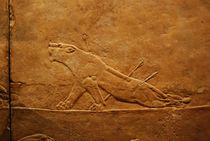صيد آشوربانيپال للأسود

الصيد الملكي للأسود من آشوربانيپال يظهر في مجموعة شهيرة من مجسمات قصر آشورية من القصر الشمالي في نينوى المعروضة حالياً في الغرفة 10a في المتحف البريطاني. وتُعتبر على نطاق واسع أنها "أعظم تحف الفن الآشوري".[1] وتُظهِر "صيداً" طقوسياً منمط يقوم به الملك آشوربانيپال (حكم 668 – ح. 631/627 ق.م.) في حلبة، حيث تـُطلـَق أسود مأسورة من أقفاص للملك كي يقتلها بالأسهم والحراب أو بسيفه.[2] المجموعة نُحتت حوالي 645–635 ق.م.، وشكلت في الأصل تسلسلات مختلفة وُضِعت في أرجاء القصر. ولعلهم كان في الأصل مرسومين، وشكلوا جزءاً من ديكور عام ملون بألوان زاهية.[3]
البلاطات أو orthostats from the North Palace were excavated by هرمز رسام in 1852–54, and William Loftus in 1854–55 and most were sent back to the British Museum,[4] where they have been favourites with the general public and art historians alike ever since. The realism of the lions has always been praised, although the pathos modern viewers tend to feel was perhaps not part of the Assyrian response. The human figures are mostly seen in formal poses in profile, especially the king in his several appearances, but the lions are in a great variety of poses, alive, dying, and dead.[5]
The carvings come from late in the period of some 250 years over which Assyrian palace reliefs were made, and show the style at its most developed and finest,[6] before decline set in. Ashurbanipal was the last great Assyrian king, and after his reign ended the الامبراطورية الآشورية الحديثة descended into a period of poorly-recorded civil war between his descendants, generals and rebelling parts of the empire. By 612, perhaps as little as 25 years after these were made, the empire had fallen apart and Nineveh been sacked and burnt.[7]
. . . . . . . . . . . . . . . . . . . . . . . . . . . . . . . . . . . . . . . . . . . . . . . . . . . . . . . . . . . . . . . . . . . . . . . . . . . . . . . . . . . . . . . . . . . . . . . . . . . . . . . . . . . . . . . . . . . . . . . . . . . . . . . . . . . . . . . . . . . . . . . . . . . . . . . . . . . . . . . . . . . . . . . .
صيد الأسود الآشوري
النقوش البارزة بالقصر
 | |
المناظر

الهامش
المراجع
- Frankfort, Henri, The Art and Architecture of the Ancient Orient, Pelican History of Art, 4th ed 1970, Penguin (now Yale History of Art), ISBN 0-14-056107-2
- "Grove": Russell, John M., Section 6. "c 1000–539 BC., (i) Neo-Assyrian." in Dominique Collon, et al. "Mesopotamia, §III: Sculpture." Grove Art Online, Oxford Art Online, Oxford University Press, accessed 19 November 2016, subscription required
- Hugh Honour and John Fleming, A World History of Art, 1st edn. 1982 (many later editions), Macmillan, London, page refs to 1984 Macmillan 1st edn. paperback. ISBN 0-333-37185-2
- Hoving, Thomas. Greatest Works of Western Civilization, 1997, Artisan, New York, ISBN 978-1-885183-53-8
- Oates, D. and J. Oates, Nimrud, An Assyrian Imperial City Revealed, 2001, London: British School of Archaeology in Iraq, full PDF (332 pages) ISBN 978-0-903472-25-8
- Reade, Julian, Assyrian Sculpture, 1998 (2nd edn.), The British Museum Press, ISBN 978-0-7141-2141-3
- Wilson, David M.; The British Museum; A History, 2002, British Museum Press, ISBN 0-7141-2764-7









